In this Cleveland hall, classical music is king (and ancient Egypt meets the jazz age)
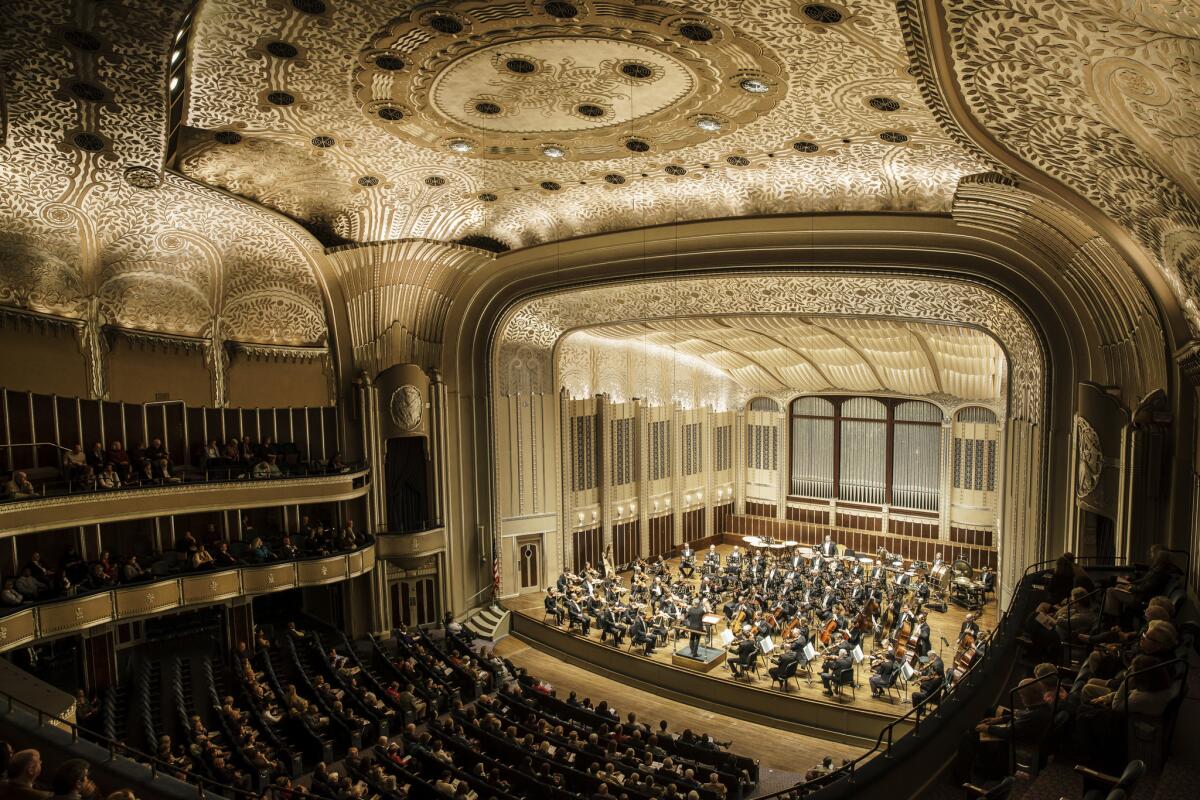
- Share via
Above, the ceiling was done up in silver, beige and blue like frosting on a wedding cake. Below, at the lip of the stage, a tall man in a black suit and white bow tie leaned forward with a tip about what I was about to hear.
“This is going to be something,” said Mark Jackobs, one of the Cleveland Orchestra’s viola players. “This is a freight train.”
Jackobs, who has played in the room for 25 years, knew just how the sound would flood Severance Hall, one of North America’s most admired classical music venues.
This was my first concert in the hall, so I had plenty of questions. But before I could ask more, the lights dimmed in the 1,920-seat auditorium, and we rushed to our seats.
Conductor Franz Welser-Möst raised his baton. A hundred musicians, including Jackobs, snapped to attention. The train, also known as Prokofiev’s Symphony No. 3, was leaving the station.
Inside the hall
When the orchestra’s leaders launched the campaign to build Severance Hall in 1928, Cleveland was on a roll. As America constructed skyscrapers, Cleveland’s steel mills were shipping vast tonnage on Lake Erie and the Cuyahoga River.
The city’s population was about to hit 900,000. The orchestra, founded in 1918, had already played New York, made its recording debut and started on the path to worldwide acclaim.
Since then, Cleveland has shrunk, suffered and been smirked at like few other American cities. But it also has reinvented itself and begun to bloom again.
As I explored the auditorium and roamed the city for four days in September, I was amazed that in the middle of a city so changed, the orchestra and its hall have never stopped doing what they set out to do.
MORE photos of Severance Hall and Cleveland »
A day before I heard the orchestra, Andria Hoy, its archivist, gave me a tour of the hall.
First, I found my way to University Circle, the cultural hub about 5 miles east of downtown, where the hall, the Cleveland Museum of Art and the campus of Case Western Reserve University sprawl alongside the grassy expanses of Wade Park.
The art museum was terrific, from the Egyptian mummy cases to the gritty canvases of New York’s Ashcan School. At the Cleveland Museum of Natural History, I got to look a live eagle in the eyes.
The concert hall, however, did not quicken my pulse right away. In fact, if architecture is frozen music, Severance Hall’s Georgian neoclassical exterior is “Pomp and Circumstance” at 23 beats a minute.
But inside, it’s “Rhapsody in Blue” meets “King Tut.” Once you step into the grand foyer, you’re swallowed by a mashup of Art Deco swoops and Egyptian Revival details.
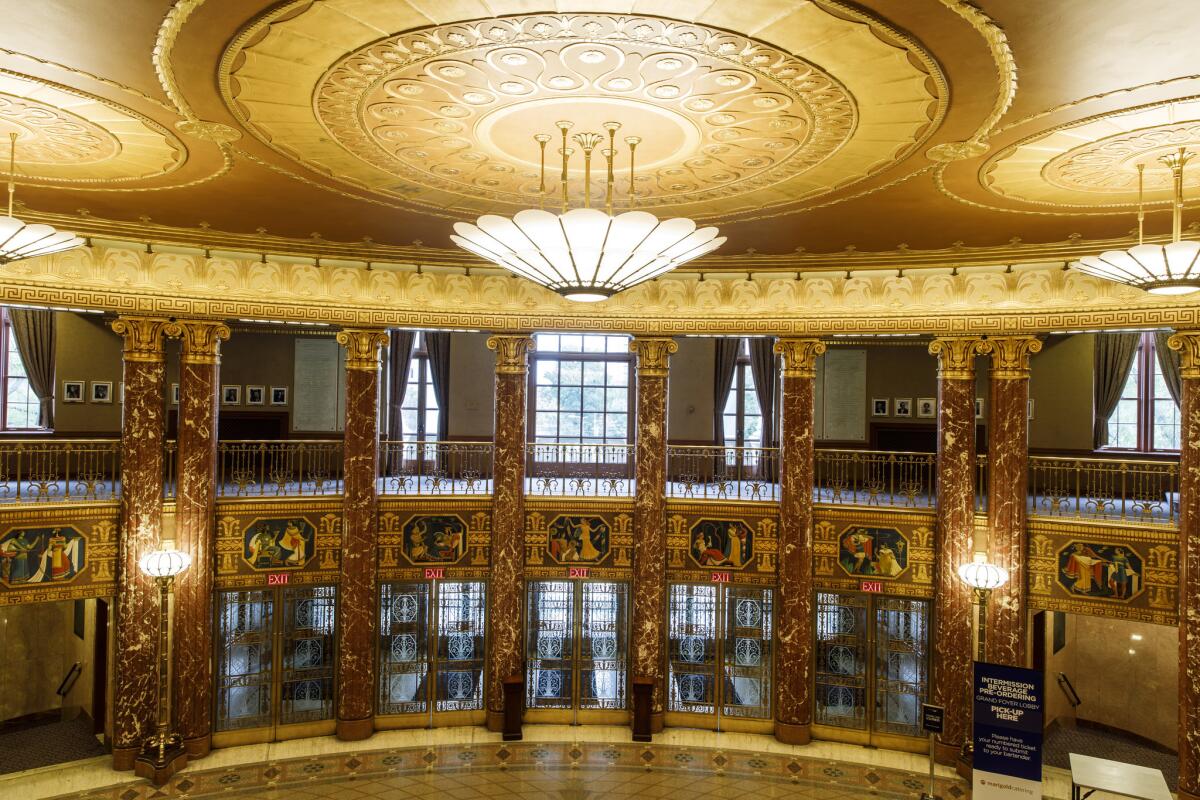
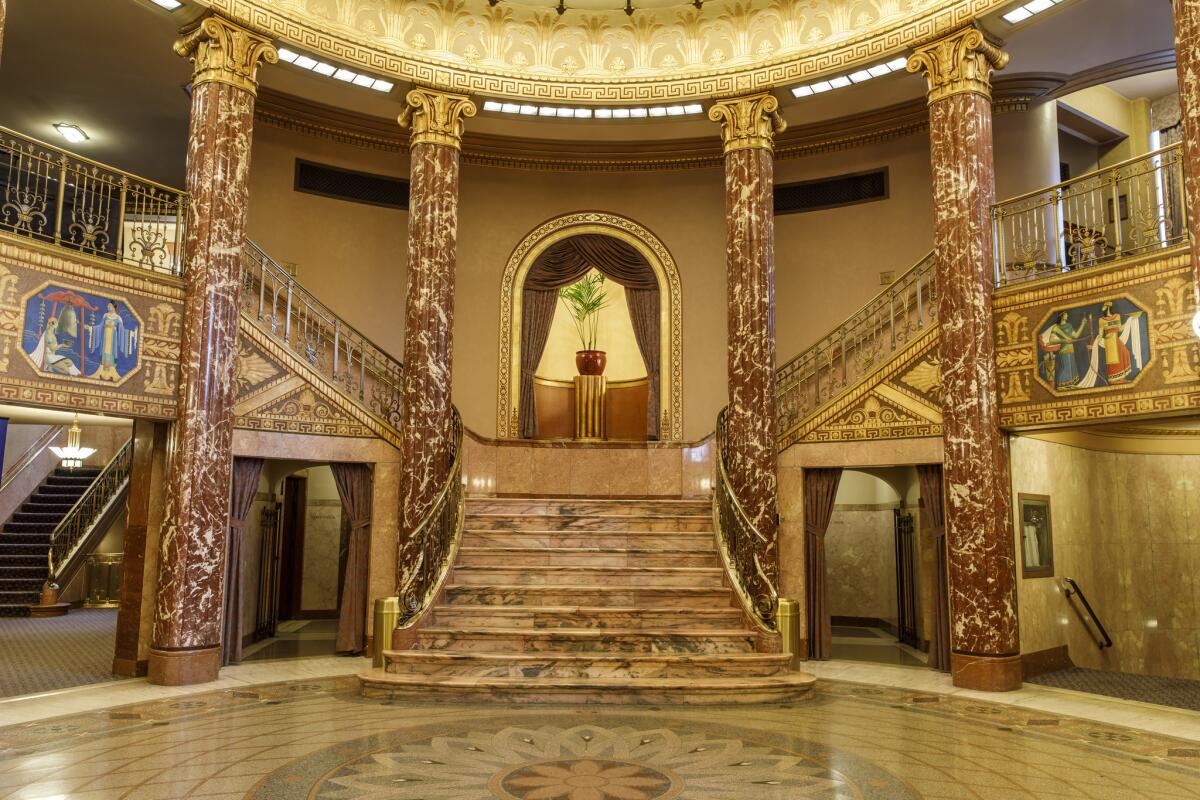
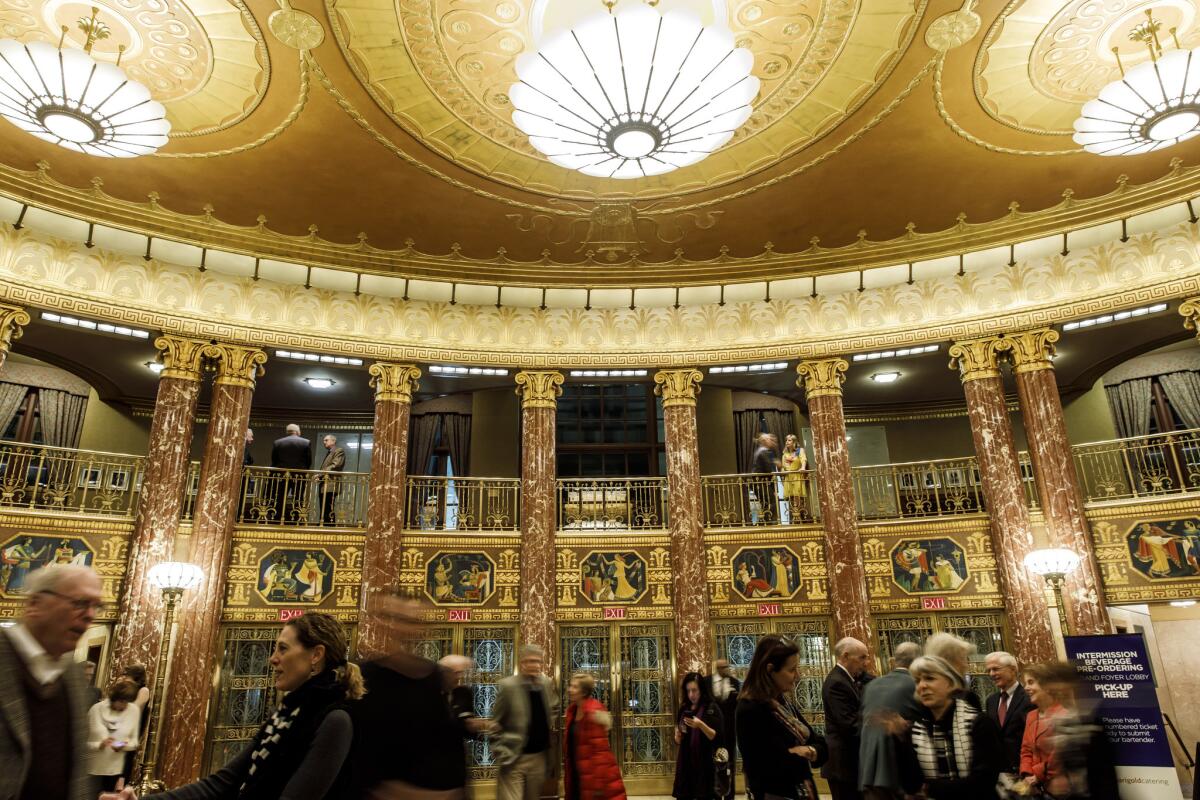
MORE photos of Severance Hall and Cleveland »
It was 1928, Hoy told me, when philanthropists John and Elisabeth Severance pledged $1 million for a project to be designed by Walker & Weeks, a local architecture firm.
Then Elisabeth died at the family winter home in Pasadena, followed by the stock market crash in late 1929. Yet John didn’t hesitate. Construction began a month after the crash, and he took every opportunity to stamp the concert hall with Elisabeth’s personality, ultimately spending more than $2 million in Great Depression dollars, about $29 million today.
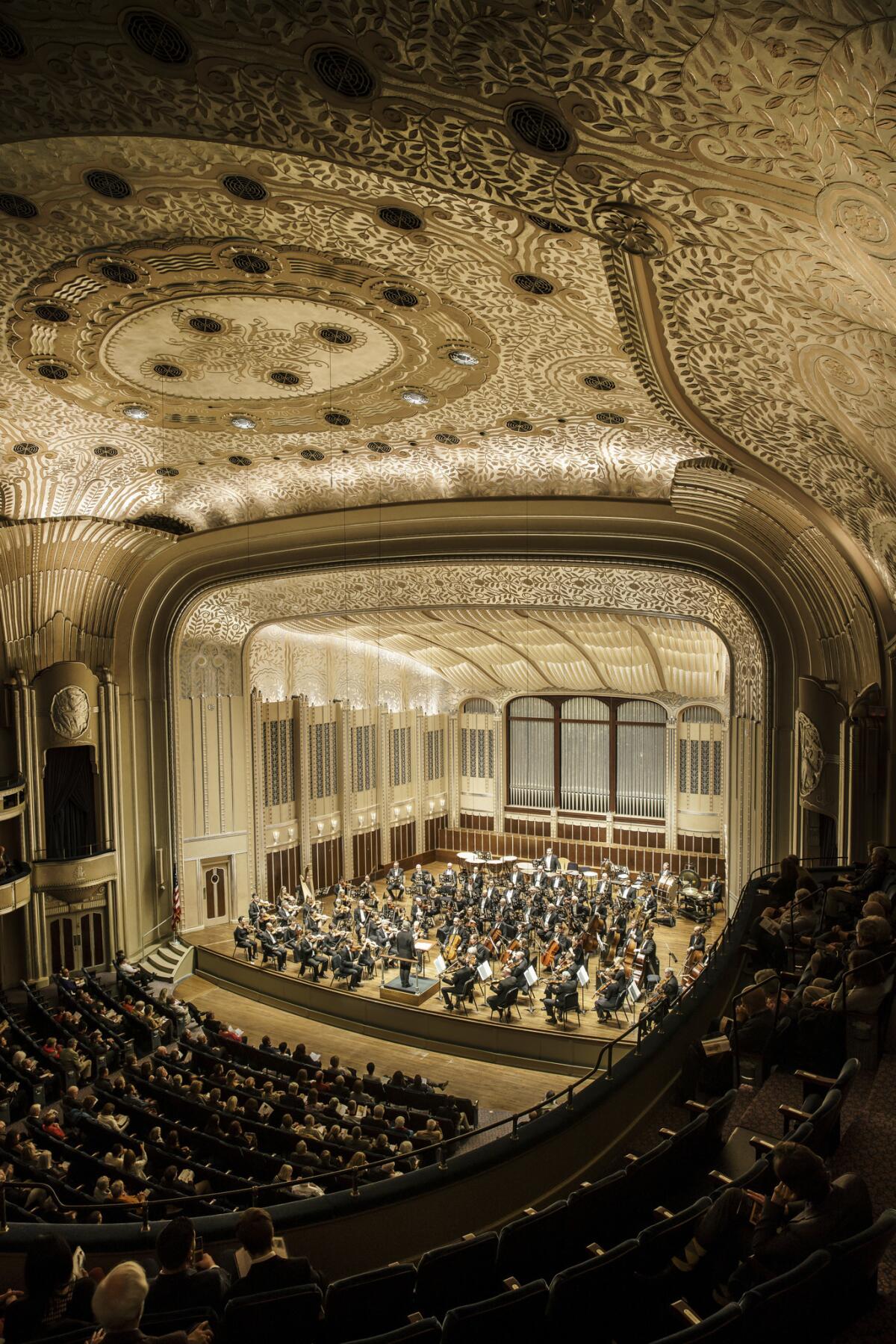
The intricate, lace-like aluminum leaf pattern on the ceiling is said to match Elisabeth’s wedding dress. Thus, also, the lotus blossoms (her favorite flower) in the grand foyer’s terrazzo floor.
As for the building’s papyrus imagery and other Egyptian Revival touches, John Severance and his family were among the legions of wealthy Americans who journeyed to Egypt in the 1920s to see King Tut’s newly uncovered tomb.
MORE photos of Severance Hall and Cleveland »
“He really turned this building into a memorial to her, which is where a lot of the opulence comes from,” Hoy told me.
The grand foyer, a double-height oval space outfitted with marble from Italy and Indiana, is surrounded by two dozen columns, a series of Egyptian Revival murals and two sets of stately stairs.
Outside the hall
The past 50 years have been rough on Cleveland. The city’s economy stumbled in the 1960s, population began to plummet, crime jumped and the Cuyahoga River, profoundly polluted, caught fire more than once. The slump lasted decades. A wicked nickname emerged: the Mistake by the Lake.
Nowadays, the city’s population is about 390,000; one steel mill remains. But Cleveland — the town that gave us Drew Carey, Halle Berry and Molly Shannon and great sports performances from running back Jim Brown of the Cleveland Browns and pitcher Bob Feller of the Cleveland Indians— has pivoted.
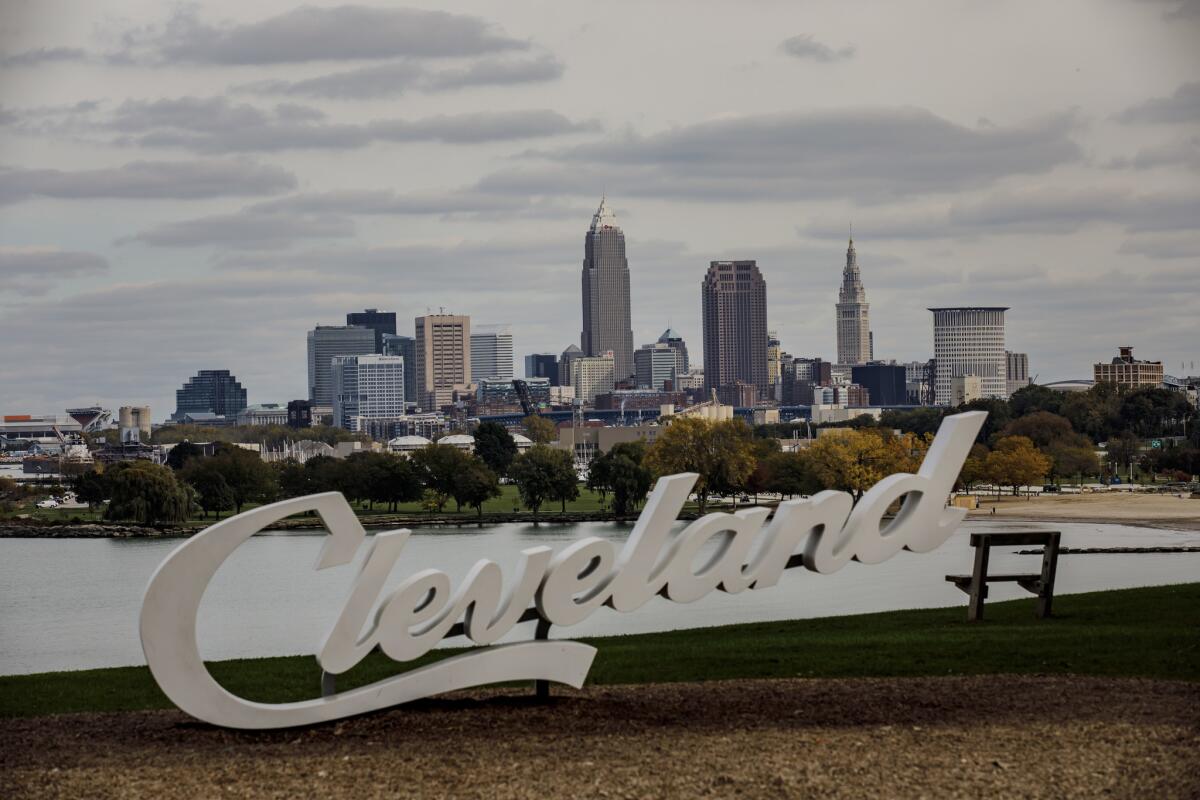
MORE photos of Severance Hall and Cleveland »
On the Cuyahoga (no flames since 1969, thank you), you can see kayaks, rowers and the Nautica Queen, a dinner cruise ship.
As downtown reinvents itself, hotels, restaurants and Heinen’s Grocery Store have taken over grand old bank buildings along Euclid Avenue. Condos and apartments are multiplying near the riverside. The Rock & Roll Hall of Fame and Playhouse Square theater district have helped push tourism up by about 25% in the past six years.
And Cleveland’s orchestra? The musicians kept playing, touring and recording, never relinquishing the reputation that spread globally under the exacting George Szell, music director from 1946 to 1970.
New York, Boston, Chicago, Philadelphia and Los Angeles may be bigger cities, but in January a New York Times headline proclaimed that “At 100, the Cleveland Orchestra May (Quietly) Be America’s Best.” (A later article in October noted that the orchestra had fired its concertmaster and principal trombonist for sexual misconduct and harassment.)
Béla Bartók, Leonard Bernstein, Wynton Marsalis, Yehudi Menuhin, Leontyne Price, Sergei Rachmaninoff and Mstislav Rostropovich — all have stood on the Severance Hall stage.
It remains the orchestra’s home for about 100 performances a year in fall, winter and spring. (Concerts move to the Blossom Music Center in Cuyahoga Falls in the summer.) The hall also hosts graduations, weddings, the Cleveland Pops Orchestra and other events.
The legacy
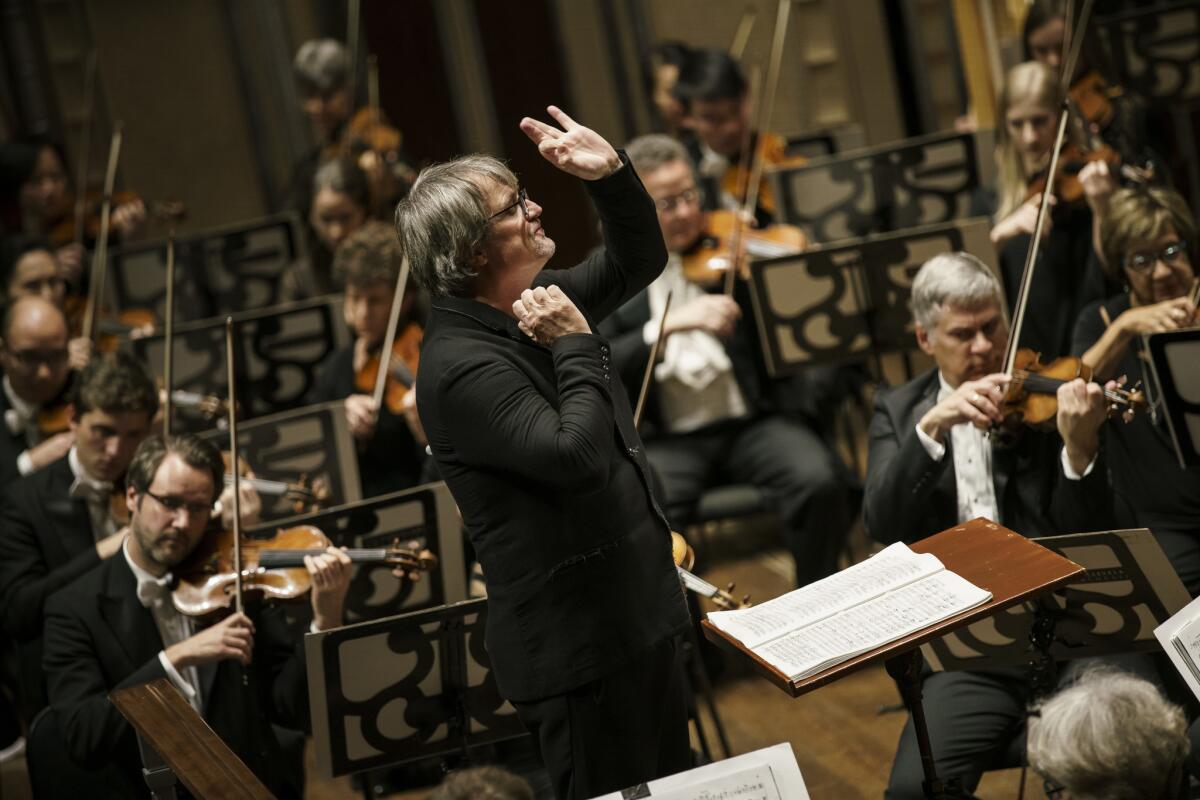
MORE photos of Severance Hall and Cleveland »
On concert night, I arrived early so I could start with a meal at Severance, the venue’s fine-dining restaurant. Solicitous service, tasty sea bass special. Good omens.
The music began with Prokofiev’s Symphony No. 1, a sprightly, sunny work despite being composed while Russia and the rest of Europe were a mess. I’m no music critic, but it sounded seamless and precise to me, and the rest of the room seemed to agree.
The hall was about two-thirds occupied, the crowd mostly 50 and older and white, although one or two sections were dominated by students. Eager to woo young and varied listeners, the orchestra offers free admission to those 18 and younger for many performances.
The next piece was Bartók’s Piano Concerto No. 2 from 1931 — a challenging, dense work featuring ferocious guest pianist Yefim Bronfman. In one passage he seemed to conjure the sound of mist rising from a pond. In another, Bronfman played with such force and speed that his whole body shuddered.
“He proved that the piano is a percussion instrument,” usher Joette McDonald whispered to me later. She’s been working concerts for 17 years “because I’m never disappointed,” she said. “It never gets old. I do. But it doesn’t.”
After intermission was the sonic assault that Jackobs had warned me about, Prokofiev’s third symphony, composed in 1928. Before beginning, Welser-Möst addressed the audience, suggesting that Sigmund Freud must have influenced this piece. He also asked us “to listen for not just the melody but what is happening underneath.”
Then, from the first note: shrieking strings and brass, booming tympani, curious three-note clusters ascending and descending — a beginning as dark and alarming as the night’s first Prokofiev piece had been bright and frisky.
From there, things calmed a bit, with plenty of delicate passages. I could relax and look around a little. But this is a symphony that began its life as an opera about demonic possession, so chaos was bound to return.
At the close of the fourth movement, Prokofiev dispatched us with a pair of booming, dissonant full-orchestra chords. Utter doom, under a twinkling aluminum ceiling.
At the Rock & Roll Hall of Fame, the amps are turned to 11 to get effects like this. In Severance Hall, they do it without amplifiers, in a suit and bow tie, just as they have for 87 years.
More music
Classical music, bread and water are all some people need. But if your appetites range more widely, Cleveland stands ready with rock and polka, beer and pirogis.
First, the rock. Before you step into the Rock & Roll Hall of Fame, a plaque explains the city’s claim on rock history: Alan Freed, a Cleveland disc jockey, popularized the phrase in the early 1950s.
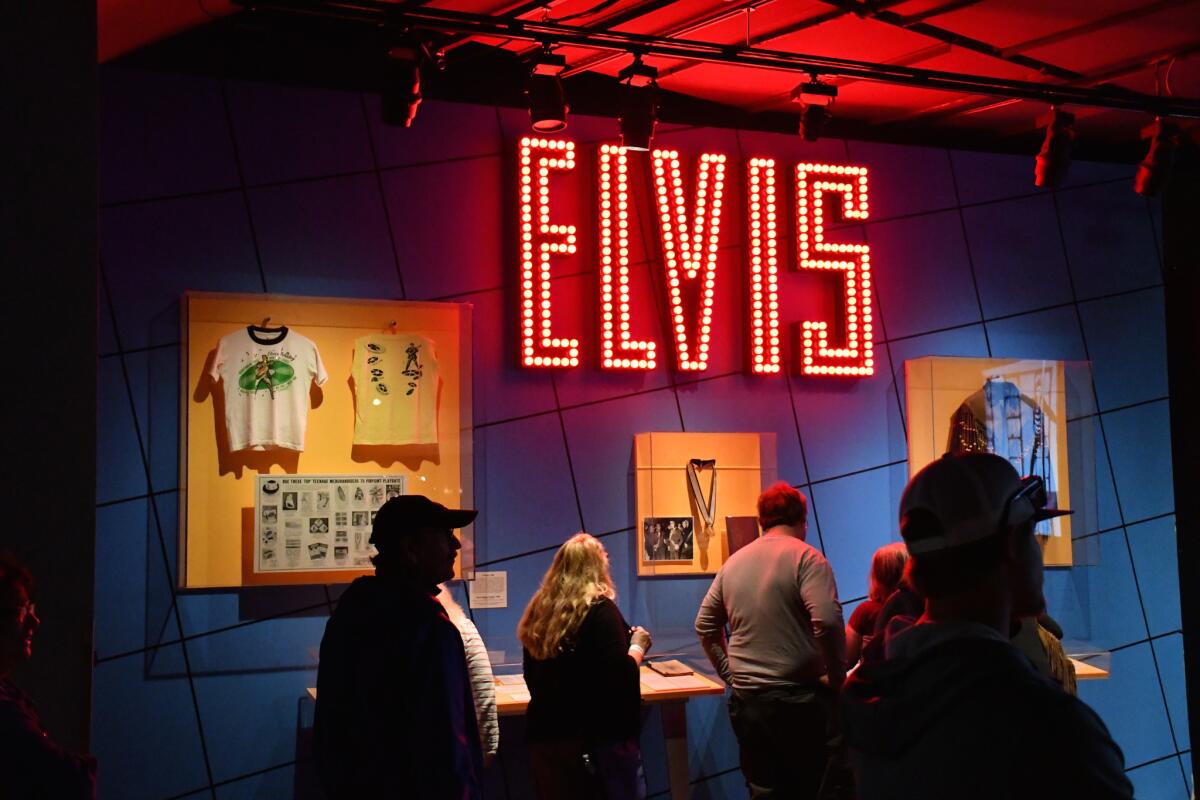
The Hall of Fame opened at the edge of Lake Erie in 1995, relying on an elaborate system of nominations and balloting to celebrate a medium that’s all about anarchy and subversion.
It has thoughtful exhibits and plenty of artifacts. Gawk at Elvis’ double-neck guitar from the early 1960s. Giggle at the 1967 “Arnold Layne” video in which the members of Pink Floyd cavort like the Monkees.
The hall has defined rock so broadly that there’s room for Jay-Z and Taylor Swift. It also has a theater where great performances are screened, including a 2009 Madison Square Garden benefit that featured Bruce Springsteen, Aretha Franklin, Stevie Wonder, James Taylor, B.B. King, Patti Smith, Mick Jagger, Metallica and many others.
As for polka, it’s a fixture in Cleveland because of the city’s Polish and Slovenian populations. I got my dose and a few pierogis at the Prosperity Social Club (1109 Starkweather Ave. in the Tremont neighborhood), where accordionist Stan Mejac holds court Wednesday nights.
If you go
THE BEST WAY TO CLEVELAND
From LAX, United offers nonstop service to Cleveland, and Delta, United, American, Southwest, Alaska and Frontier offer connecting service (change of planes). Restricted round-trip airfare from $353, including taxes and fees.
WHERE TO LISTEN
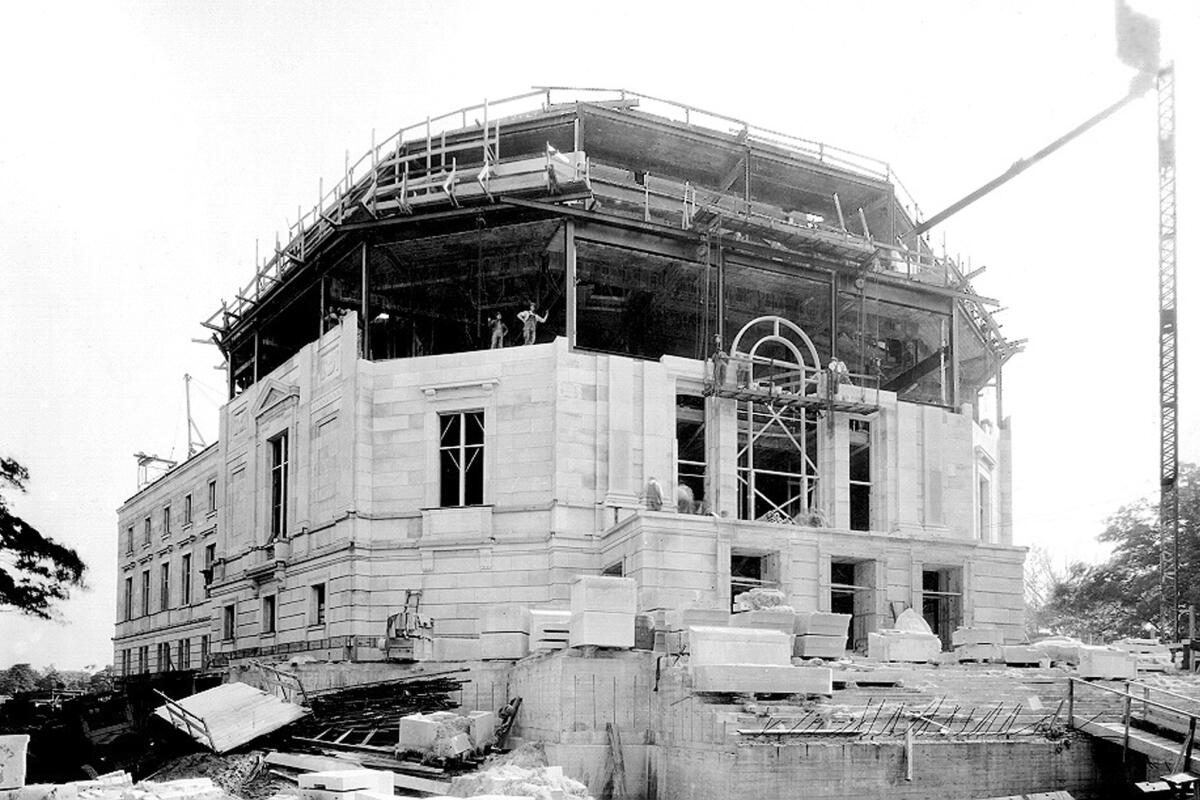
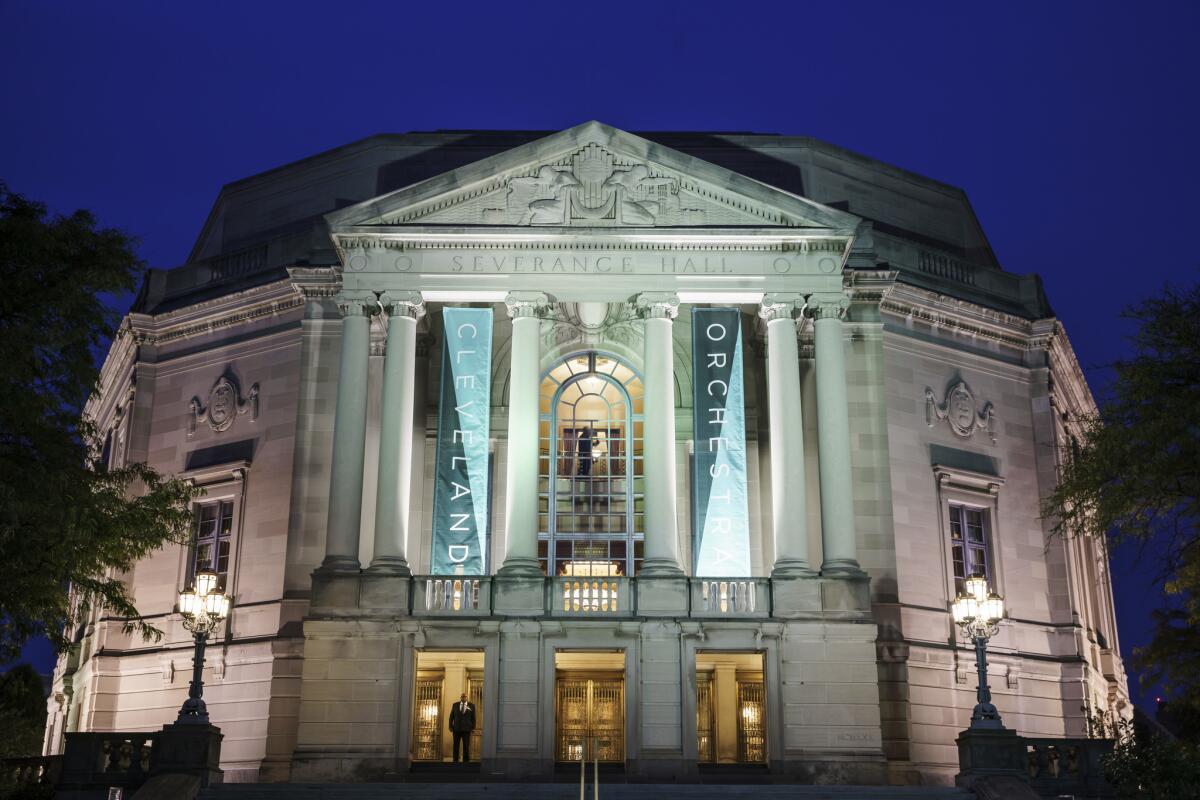
Severance Hall, 11001 Euclid Ave., Cleveland; (216) 231-1111. Offers about 100 Cleveland Orchestra performances per year along with dozens of other events. Public tours, which last two hours and are free, are offered once or twice a month; reservations required. The next tour dates are Nov. 30, Dec. 28, Jan. 22, Feb. 21 and March 23. (216) 231-1111.
Rock& Roll Hall of Fame, 1100 E. 9th St., Cleveland; (216) 781-7625. Open daily; adult admission $23-$26; discounts for seniors, military and students.
WHERE TO STAY
Metropolitan at the 9, 2017 E. 9th St., Cleveland; (216) 239-1200. Upscale hotel with rooftop lounge and a bit of Vegas flavor. Doubles from $209 a night.
Renaissance Cleveland Hotel, 24 Public Square, Cleveland; (216) 696-5600. Old-world upscale lodging in a 1918 building. Doubles from $200 a night.
Holiday Inn Express Cleveland Downtown, 629 Euclid Ave., Cleveland; (216) 443-1000. Mid-level lodging in an 1890s bank building. Doubles from about $110.
Cleveland Hostel, 2090 W. 25th St., Cleveland; (216) 394-0616. Bright, clean hostel across the street from the popular West Side Market (and a subway station). Beds in dorm rooms $26 and up.
Kimpton Schofield Hotel, 2000 E. 9th St., Cleveland; (216) 357-3250. Reborn 1900s building with doubles from $128 a night.
WHERE TO EAT
Larder Delicatessen & Bakery, 1455 W. 29th St., Cleveland; (216) 912-8203. This artisan deli opened early this year in part of an 1854 firehouse. Breakfast, lunch and dinner. Specials $8-$12.
Greenhouse Tavern, 2038 E. 4th St., Cleveland; (216) 443-0511. Lunch, dinner, weekend brunch. Dinner main dishes $21-$65.
Collision Bend Brewing Co., 1250 Old River Road, Cleveland; (216) 273-7879. Riverfront dinner and drinking in the Flats East Bank neighborhood, brunch and lunch on weekends, frequently live music. Upscale pub grub and pizza. Dinner main dishes $14-$24.
TO LEARN MORE
Destination Cleveland Visitors Center, 334 Euclid Ave., Cleveland; (800) 321-1001
Follow Reynolds on Twitter: @MrCSReynolds
Sign up for The Wild
We’ll help you find the best places to hike, bike and run, as well as the perfect silent spots for meditation and yoga.
You may occasionally receive promotional content from the Los Angeles Times.




